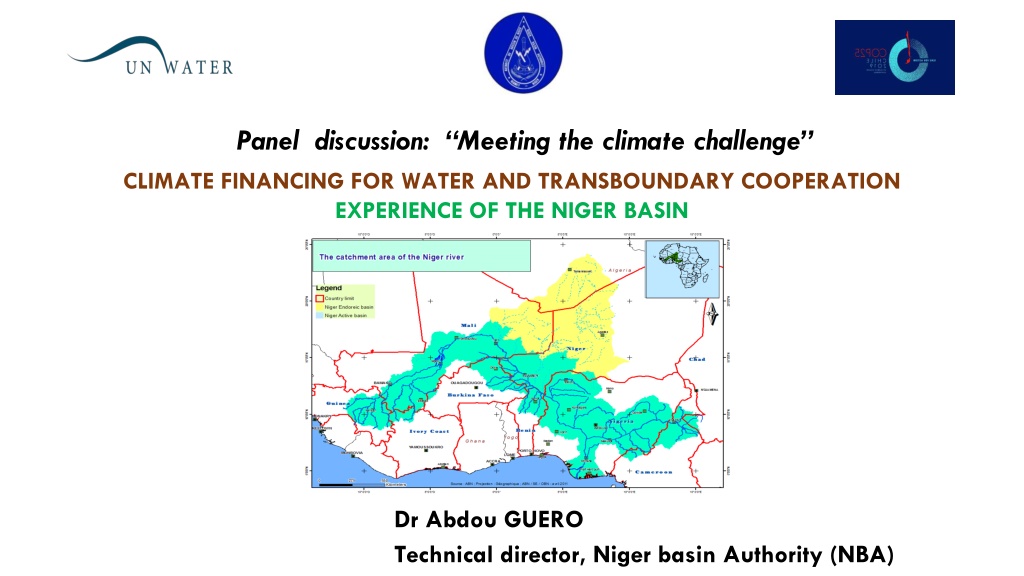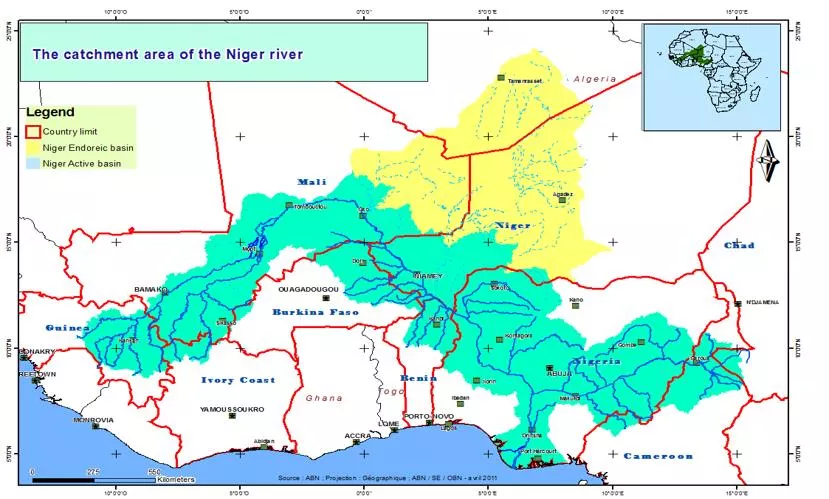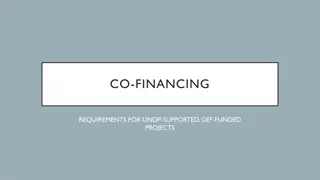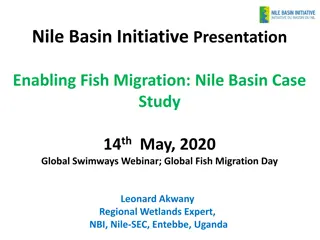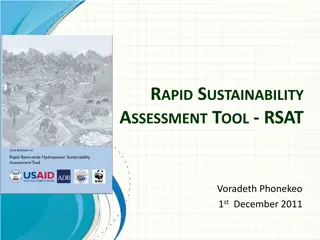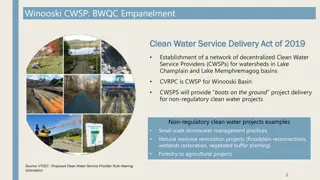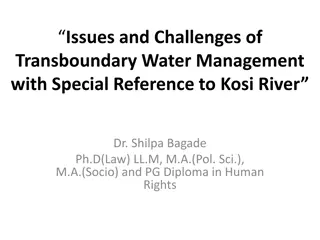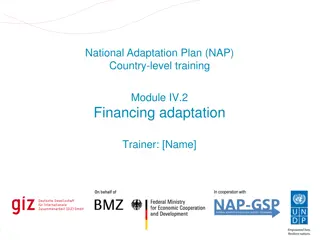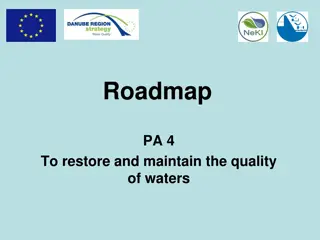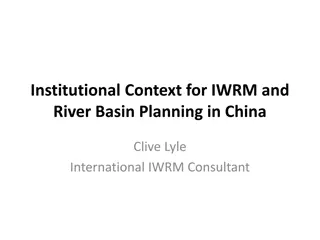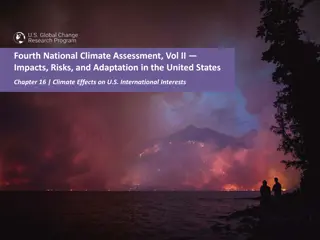Climate Financing and Transboundary Cooperation in the Niger Basin
The panel discussion explores opportunities and challenges in mobilizing climate funds for joint actions in transboundary basins, focusing on the experience of the Niger Basin Authority. It highlights the importance of international commitments, regional cooperation, and sustainable local community involvement in managing climate change and water-related challenges. The example of transboundary cooperation in the Niger Basin showcases the significance of political will and shared vision for climate change adaptation.
Download Presentation

Please find below an Image/Link to download the presentation.
The content on the website is provided AS IS for your information and personal use only. It may not be sold, licensed, or shared on other websites without obtaining consent from the author. Download presentation by click this link. If you encounter any issues during the download, it is possible that the publisher has removed the file from their server.
E N D
Presentation Transcript
Panel discussion: Meeting the climate challenge CLIMATE FINANCING FOR WATER AND TRANSBOUNDARY COOPERATION EXPERIENCE OF THE NIGER BASIN Dr Abdou GUERO Technical director, Niger basin Authority (NBA)
1. OPPORTUNITIES AND CHALLENGES RELATED TO THE MOBILIZATION OF CLIMATE FUNDS FOR JOINT ACTIONS IN TRANSBOUNDARY BASINS OPPORTUNITIES Mobilization of the International Community on Climate through the Paris Agreement, including through developed countries commitment to provide at least $ 100 billion per year between 2020 and 2025, from public and private sources, for mitigation and adaptation projects. Commitments of RBOs Member Countries within the framework of the Paris Agreement, and willingness to pool means through climate investment priority plans and programs of cooperation institutions (NBA, G5-Sahel, LCBC, etc) to allow coordination of actions and avoid mis-adaptation at basin scale. Commitment to countries of financial institutions and the United Nations system to facilitate funding to support climate resilience actions. Possibility for RBOs to mobilize regional funds (often not accessible to countries) for adaptation measures at basin scale.
1. OPPORTUNITIES AND CHALLENGES RELATED TO THE MOBILIZATION OF CLIMATE FUNDS FOR JOINT ACTIONS IN TRANSBOUNDARY BASINS CHALLENGES Fulfilment of countries commitments (Contribution of each country and public or private funding sources). Capacities of countries and RBOs to develop and implement relevant operational projects and programs required to mobilize funding announced by financial partners. Development and implementation of legal frameworks required for transboundary cooperation; Reduction of operational projects and programmes preparation duration (often too long due to weak countries capacity and donors procedures)
2. HOW SUSTAINABLE EMPLOYMENT OF LOCAL COMMUNITIES CAN HELP MANAGING CLIMATE CHANGE AND WATER RELATED CHALLENGES Employment of local communities must be reflected through their participation in the identification, planning and implementation of adaptation actions, which guarantee ownership of these actions (tools, techniques, methods, management of adaptation infrastructures ) and their sustainability. Empowering local communities, especially young people through SMEs creation, to valorize adaptation infrastructures. Strengthening local communities adaptation capacities (awareness raising, support, training) in order to prompt fast adaptation actions.
3. EXAMPLE OF TRANSBOUNDARY COOPERATION FOR CLIMATE CHANGE ADAPTATION IN THE NIGER BASIN Political will of NBA Member Countries to cooperate on the basis of solidarity and reciprocity, expressed through the SHARED VISION, enabled: 1. Adoption, in April 2008, of Sustainable Development Action Plan, including 2008- 2027 Investment Program; Updated in 2016 through 2016-2024 Operational Plan incorporating Climate Investment Plan. 2. Adoption, in 2008, of Niger Basin Water Charter (with 4 annexes adopted), in force since July 2009; 3. Development of water allocation and management tools and of a flow forecasting tool based on a network of 115 hydrological stations, of a satellite monitoring system for water resources, of 9 national and 1 regional hydrological databases. 4. Setting up of 9 national and one regional basin natural resources users coordination mechanisms; 5. Mobilization of $ 307 million for 11 ongoing regional projects with the support of several TFPs (WB, ADB, FVC, FSC, GEF, EU, BMZ, AFD, Netherlands, CIWA, UNDP, UNIDO, UNEP, OSS).
3. EXAMPLE OF TRANSBOUNDARY COOPERATION FOR CLIMATE CHANGE ADAPTATION IN THE NIGER BASIN Climate Investment Plan of the Niger Basin (PIDACC/BN) funded by AfDB, leading with other partners (FVC, EU, GEF, KfW, FSC, Gvts) for USD 232 million, of which 80% donation, will allow, among others, the creation of more than 100,000 youth jobs through infrastructures construction for adaptation and restoration of degraded lands. PERSPECTIVES Continuation of Niger Basin Climate Change Resilience Development Program (PDReCC) preparation, with US $ 500 million World Bank funding. Preparation in 2020 of a Hydropower Development Program in the Niger Basin. Preparation of an irrigated agricultural program in the Niger Basin Operationalization of the Cooperation Framework Agreement with G5-Sahel as part of the implementation of our respective investment programs. Enhanced cooperation with the United Nations system, including with ILO
THANK YOU FOR YOUR ATTENTION
